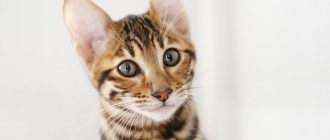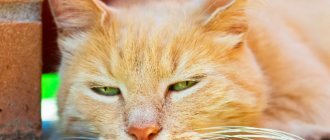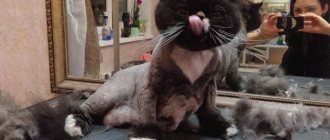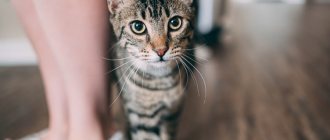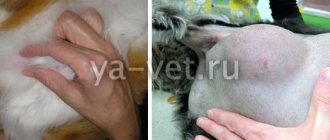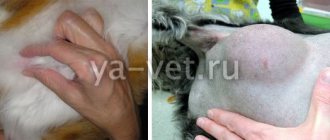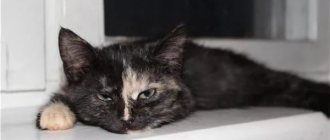Why do cats knead a soft blanket with their paws or try to trample on their owner before taking a comfortable position? And although not a single healthy cat can do without this procedure, this question still haunts the minds of the owners of these cute animals.
The reason for this behavior has genetic roots, but can also be an indicator of an outburst of emotions or a manifestation of joy and love. Let's figure out why cats crush objects or people with their paws, and how to benefit from this behavior.
Cat paws
Reasons for such activity
Each animal has its own physiological characteristics. Cats have a heightened sense of touch, through which they perceive the fullness of the world around them. They can sense the reality around them with the help of their paws, antennae and even eyebrows. A cat's whiskers often convey the cat's emotional well-being; each breed can have its own special appearance. And the pet’s paws have many tactile receptors, through which the cat gets acquainted with the situation around it.
Cats knead their paws in place, as if working as a “little cook”, kneading the dough; such movements are usually called “milk steps”. Some furry pets also purr gently, which adds emotion to both the cat and its owner. Let's look at the reasons why cats crush a person or some object with their paws.
What is catnip - photo and description
Catnip (lat. Népeta catária) is a low perennial herbaceous plant with heart-shaped leaves and small light lilac flowers collected in a tassel.
There are more than 200 subspecies of catnip.
The height of some plants reaches about 100 cm, while others are less than half a meter. The appearance of the stem is uneven, the flowers look like small bouquets, seem to be collected together, have a white and pinkish color with brown spots, and sometimes purple.
Some flowers have wavy edges. And the leaves look like someone cut them in the shape of a heart.
The aroma of catnip is simply amazing: geranium, rose and lemon combined together.
Where does catnip grow?
Catnip can be found in literally all regions from the European part to the Far East; the grass sprouts in forests, fields and garden plots.
Countries where catnip (catnip) is found: Europe, Africa, America.
Currently, catnip grows almost all over the earth, since the plant is resistant to different climates.
Emotional release
Cats, like people, have different moods and even psychological fatigue accumulated during the day. The cat could have been offended by a neighbor's dog, or he may have been driving for a long time with his owner in the car, or perhaps the cause of the cat's stress is a lack of attention from his owner. Therefore, one of the main reasons why cats knead the owner’s paws or the blanket may be that the cat wants to throw out emotions and thus simply relax.
The soft and pleasant surface of a warm blanket or other object can cause the release of joy hormones - endorphins. Do not try to stop your cat from making such movements - you will only cause aggression in the animal, the cat may even bite you hard for this. Pregnant cats try to remove pain or discomfort by fingering their paws.
If a cat releases her claws silently, without purring, most likely she is trying to get rid of the feeling of resentment at the lack of attention from the owner, and sometimes his reproach or screaming at some points. Therefore, by understanding this reaction of animals, you can easily figure out how your cat is feeling at the moment.
Cats Yawn: Physiological and Psychological Basis
A yawn in a cat is an uncontrolled breathing process in which a slow, deep inhalation occurs and a rapid exhalation occurs. As a result, the blood is enriched with oxygen and brain function improves. Animal physiology and psychology will help you understand why cats yawn.
© shutterstock
Psychological yawning
A person yawning in a crowded place feels uncomfortable. Cats are the opposite: they yawn demonstratively to show their superiority and dominant position in a given territory. In films about wildlife, you can often see a lion lying in a clearing and yawning sweetly. By this he indicates to others their subordinate status.
In the process of yawning, a cat shows off its teeth and muscles.
Physiological yawning
The physiological basis of the yawning process is related to the need for oxygen to enter the body. So, a cat yawns:
- After waking up from sleep. When a cat sleeps, the whole body rests, processes slow down, including blood flow. Carbon dioxide accumulates. To saturate the brain and organs with oxygen, the cat yawns and stretches. As a result, the body's functioning returns to normal.
- In preparation for physical activity. Cats, like many predators, lie low, wait for prey, and then make a quick dash. The running speed of an animal directly depends on the work of the heart and the quality of oxygen saturation of the brain. Therefore, before making a jump, the animal yawns, feeding on oxygen, so that it can then quickly be used up.
- In the evenings. A cat's yawning in the evening does not mean that she wants to sleep. Cats are nocturnal predators. They sleep during the day and hunt at night. And the yawning of a cat is preparation for night life, for active actions.
Memory of childhood instincts
When a kitten is born, the movement of “flicking with its paws” is one of the first that it makes unconsciously. Newborn kittens thus knead the belly of their cat mother, provoking milk production. That is, this movement is genetically embedded in them from birth. The cat remembers how warm and cozy it was to lie against his mother’s belly, so he tries to reproduce such pleasant memories. This instinct allows us to answer the question why cats knead the blanket with their paws and purr.
Top famous couple names
- Adam and Eve
- Adonis and Venus
- Diamond and Diamond
- Aristotle and Plato
- Bucks and Euros
- Barbie and Ken
- Baron and Baroness
- Black and White
- Black and Knight
- Bart and Homer
- Bach and Beethoven
- Babe and Ruth
- Belka and Strelka
- Volvo and Skoda
- Bosnia and Herzegovina
- Batman and Robin
- Wai and Fai
- Venus and Mars
- Windows and Vista
- Winnie the Pooh and Piglet
- Champagne and Provence
- Question and answer
- Crow and Cheese
- Gadget and Gizmo
- Harry and Potter
- Duke and Duchess
- Thunder and lightning
- David and Goliath
- Day and night
- Jill and Jack
- Gin and Tonic
- Dick and Jane
- Dr Jekyll and Mr Hyde
- Donald and Daisy
- Dow and Jones
- Zeus and Apollo
- Zig and Zag
- Son-in-law and Mother-in-law
- Ying and Yang
- Isaac and Babel
- Cyril and Methodius
- Karna and Arjuna
- Click and Clack
- Cola and Pepsi
- King and the Clown
- Coffee and Cream
- Cat and Mouse
- Frankincense and Myrrh
- Lal and Yakhont
- Lucky and Strike
- Legend and Myth
- Fox and Grapes
- Lewis and Clark
- Macaroni and Cheese
- Mars and Jupiter
- Martini and Daiquiri
- Mars and Bounty
- Meg and Peg
- Mickey and Mini
- Fashion & Style
- Mozilla and Opera
- Hammer and Nail
- Knight and Day
- Nike and Reebok
- Napoleon and Josephine
- Science and life
- Oil and gas
- Nika and Fortuna
- Newton and Apple
- Fire and Water
- Oscar and Emmy
- Pixie and Dixie
- Ping and Pong
- Zuid and West
- East and Side
- Plus and minus
- Prince and Princess
- Proton and Neutron
- Remote and Button
- Rock and Roll
- Hammer and sickle
- Elephant and Moska
- Salt and pepper
- Soft and Hard
- Tyson and Holyfield
- Titz and PR
- Thick and thin
- Trinidad and Tobago
- Will and Smith
- Phobos and Deimos
- Flint and Stone
- Flora and fauna
- Foot and Ball
- Hari and Krishna
- Hip and Hop
- King and Queen
- Tsar and Tsarevich
- Humpty and Dumpty
- Thorn and Rose
- El and Elf
- AC and DC
- Yandex and Google
We recommend watching: 398+ beautiful Russian names for horses and stallions
Lady and the Tramp are together again
Getting ready for bed
This interesting instinct was inherited by domestic cats from their wilder relatives. In their natural environment, cats that live in nature “trample down” their sleeping area in this way: they crush the grass, level the surface and drive away annoying insects. They do all this for their convenience and comfortable sleep. For the same purpose, a domestic cat crushes its belly or objects under its paws with its paws - most likely, it simply “tramples down” its bed for a long and restful sleep.
The cat is crumpling the blanket
How to deal with a cat's meowing
. When you give in to meowing, the cat understands that pestering you is an effective means of getting his way.
2. There may be health problems that can cause excessive meowing. Deaf cats, older cats suffering from feline Alzheimer's disease, stressed cats suffering from separation anxiety, and those with thyroid, heart or kidney problems may howl.
However, in healthy cats, the only way to stop her meowing is to completely ignore the cat.
This means you don't get up to feed her; you don't allow yourself to play tag; you don't yell at her, splash water on her, or give her any attention at all.
It's hard to do that when she's stroking your nose or shaking the windows with her screams.
Marriage span
Cats are always overly active when their mating season begins - they immediately physiologically feel that it is time to have offspring. At this time, your little friend is most active. The cat becomes very active, can move its paws a lot, arch its back and perform additional actions. That's why cats knead a person's paws and purr - perhaps your pet wants to tell you something. Do not react aggressively to the cat's behavior during this period - she may bite and become very angry. After pregnancy begins, the cat’s activity will begin to decline.
What does meowing mean?
Cats use a wide range of meows to communicate with other cats, but seem to reserve “meowing” primarily for communicating with their humans.
What exactly does the pet want?
How do you understand them - are they showering you with cat curses, praising your taste in art, or just annoying you for fun?
<
Meowing is a demand: “let me out”, “let me in”, “pet me”, “play with me”, “feed me!”
As the cat becomes more insistent, its meows sound increasingly harsh and low-pitched. Meowing most often occurs in the wee hours of the night when owners want to sleep.
Marks his territory
Another important factor - why cats crush a blanket or other object with their paws is the genetic predisposition of cats to “mark” their territory. Having studied the smell of this or that object and choosing their favorite objects and places, cats crumple them so that other animals do not lie in their place. This way they show that this is their sofa or their blanket. This primarily concerns females, but cats have different habits - they mark places with their secretions to give them a special smell.
Types of cat meows
There are four main categories of meows:
1.Purple patterns include purrs and trills.
2. Vowel patterns are meows in all their variations (cats can produce multiple diphthongs too).
3. Articulated patterns are chirps and chatters that express frustration.
4. Tense intensity patterns are warning signs such as hissing and growling.
Experts also suggest that some cat meows may be so subtle or at such a high frequency that only other cats can hear them.
Not all cats are talkative. For example, Persians and Blue Chartreuses tend to be fairly quiet. Other cat breeds never stop talking: Siamese breeds are especially talkative.
Massotherapy
Surprisingly, cats can not only relieve stress, but also give you a soft and pleasant massage with their paws. What does it mean when a cat kneads its paws - it is simply trying to thank you for a delicious dinner or for showing concern for it. The therapeutic effect comes not only from the cat massaging different parts of the body, but also from its purring during the process itself.
This helps a person to rest and relax after a difficult day. Some owners, for the sake of cat trampling, are ready to endure “accidental scratches” that they may accidentally receive during a massage.
The cat is ready for mating
The first mating of a cat is due to estrus, which occurs in the first year of her life. The age of maturity in pets occurs after six months, but during the first heat the cat cannot be taken to a partner. The body is not yet fully formed, because of this, pregnancy can be much more difficult, complications and pathologies may appear.
Therefore, the first mating must be planned starting from the age of one and a half years, or after the 3rd heat. The body is fully formed, the hormonal levels are stable, and she is ready to bear offspring.
Sign of love and devotion
Experienced zoologists say that a pet expresses its love for its owner by fingering its paws. This is how your kitten shows that he is grateful for petting or scratching his neck, and perhaps for a delicious cat dinner. In addition, the cat, as it were, “marks” its owner with such movements, showing to other animals that this person is his property. Sometimes, in gratitude, the cat tries to warm the person by lying on his stomach or other parts of the body.
Cat on the sofa
What should the owner do
If you want to have a trusting relationship with your cat, you should not scold him at the moment of releasing his claws. After all, most likely, the cat does this out of good intentions and a good mood. At this moment, all pets are especially sensitive and receptive, since often this fingering of their paws is also accompanied by a melodic purring.
If you feel pain or discomfort from your cat's prehensile claws, you should gently stroke his paws so that he calmly removes them or switches to another object. Also try to move to the side, but you need to do this very carefully so as not to offend the animal.
These tricks will help you avoid scratching your friend:
- Place a thick blanket or blanket under the claws, then the cat massage will not be so painful for you.
- Very gently roll the cat onto its side to redirect its attention. Pat him on the head at this moment.
- Distract your cat's attention with a toy or thing he loves.
- Try petting your pet or scratching its neck.
- You can press lightly on the front paws so that the cat hides its claws.
- If you enjoy stroking your cat's paws, trim your cat's claws regularly.
Night meow
Cats typically sleep 16 hours a day and are most active at night. They perform mouse patrol movements both outside and inside. It's annoying, but that's normal.
A determined and intelligent cat will visit the bedroom and may even snuggle up to you and sleep with you for part of the night until it decides you've both had enough sleep.
First he bites your nose or toes, or drops toys on his head. If this doesn't wake you up, the meowing will get louder.
As soon as you roll out of bed, the cat runs ahead of you to its empty food bowl. Filling the bowl can, in fact, temporarily stop the howling.
It is difficult to meow with a mouth full of food.
What not to do
There are a few simple rules for how to behave when a cat crushes objects:
- The main thing is not to scold your pet, so as not to lose his trust.
- Under no circumstances punish the cat for such actions, because this is his natural instinct.
- You cannot use physical force to prevent your pet from trampling down the blanket.
- Don’t limit your attention after the cat’s behavior like this, continue to encourage and pet him.
By following these simple rules, you will maintain a trusting and friendly relationship with your little family member.
Recommendations for the owner
A cat for breeding must be selected before the cat goes into heat. There are a number of rules that you need to follow in order to choose the right pair for your pet.
- If the cat is purebred, it can only be crossed with those breeds that are acceptable for mating. The list of breeds can be obtained from a veterinarian, he will advise and explain the characteristics of each
- When choosing a cat, you need to take into account the blood type, it should be exactly the same as that of the cat. Under no circumstances should pets with different blood types be allowed to mate, as complications may arise during pregnancy.
- The cat should not be given hormonal drugs that are aimed at suppressing empty estrus; this can also cause complications.
- In order to properly prepare a pet for mating, she must be vaccinated on time and treated against all possible parasites; she must be completely clean, just like the cat. Carrying out bathing procedures 2 weeks before mating is strictly prohibited. This is done so that the fur retains the smell that it releases during estrus.
- For the first mating, you need to select an experienced cat, this is done in order to speed up the process. It is not uncommon for a cat to be afraid of a cat and try to scare it away. The process may take a long time, or the acquaintance may not take place.
- Keeping a cat 2-3 days before estrus should be carefully discussed with the cat's owner, this will prepare the pets for each other and eliminate the possibility of fright when meeting.
Cat therapy
When a kitten crushes objects or a person with its paws, it also has a beneficial therapeutic effect on its owner - it gives him its energy and takes away bad mood, depression, fatigue and negativity. In alternative medicine, it is known that massage with a cat has healing powers.
In some situations, this technique is even specifically used:
- Cats can alleviate negative symptoms for people with autism, cerebral palsy, or people with various disabilities.
- Sometimes these pets are able to help a person get rid of chronic diseases through a strong energy field.
- Cats can ease symptoms after inflammatory processes or reduce post-operative manifestations.
- People who have cats in their homes are less susceptible to viral and infectious diseases.
- Cat energy can help heal bone fractures.
- The purring of your pet will calm you down after a hard, busy day, help you overcome stress and strengthen your nervous system.
Cats also have unique intuitive feelings - they try to be alone with their owner if they feel that he is feeling bad or is very upset. If a person has pain in some place, the cat can lie down on the painful area. It is believed that cats sense the approaching death of their owner, so when this occurs they try to be close to him.
Such incredible qualities of pets should be appreciated, responding to them with love and care for their affection towards the owner.
What is catnip for and why do cats need it?
What are the benefits of using catnip. It is often believed that the cat plant serves as a behavior correction for some cats. For example, in highly aggressive pets, after they eat catnip, their behavior becomes docile and calm, while slow and lethargic cats can become active and playful.
Catnip mint (dry catnip) photo
It has also been established that the use of this herb has a bactericidal effect, that is, it relieves stomach spasms.
Veterinarians testify that catnip is a suitable remedy for stressful situations for animals. They can easily withstand travel and trips to the veterinary clinic. Also, this herb does not act as a strong drug; the cat will not get used to it if you watch your pet and do not let it near catnip often.
After catnip became popular among cats, many experts began to produce special toys for cats with the smell of catnip.
Some owners make their own artificial mouse from rags and add dried cat grass inside.
Many homes use drops (mint spray) that are placed on special devices for cats where they scratch their claws. Thus, cats do not spoil good furniture and fabrics, but get used to the fragrant scratching post.
If your cat doesn't have an appetite, you can add some dried or fresh catnip leaves to the food. It is important to note that catnip is considered an anthelmintic.
If this healing herb is not available in nature, you can plant it in a pot and place it on a windowsill where the sun's rays constantly fall. Watering frequently is not recommended; the soil should be non-acidic. To prevent your pet from eating all of the catnip at once, after ripening the plant should be picked, crushed and dried. It is better to keep it away from cats and cats in a place inaccessible to them.
In addition to the fact that cats love this grass, it is also rich in nectar, so bees are also partial to it. It is also added to vermouth, shampoo, and perfume.
Raw catnip photo
Catnip mint is used as a spice in confectionery, in soap making, and for cosmetic purposes. They found that the herb has a healing effect on many diseases: it improves the gastrointestinal tract, soothes migraines, and eliminates cough. Catnip also improves blood circulation, can cleanse the lungs, and overcome insomnia.
External preparations are made from catnip to treat boils, tumors and are used in case of skin inflammation. In such cases, herbal preparations act as an antibiotic.
And catnip can also help protect against mosquitoes.
When should you not use catnip?
If your cat is pregnant, you should protect her from stressful situations and not overstimulate her with catnip. There are also cats that react too violently to this plant, because the nervous system is exhausted due to frequent emotional outbursts. In general, nature prescribes in them which plant is required in specific cases and in what quantities.
The benefits of being friends with a cat
Friendship with your pet cat can be not only pleasant, but also mutually beneficial, since the owner receives many pleasant bonuses in return:
- When you pet a cat, you get the same pleasure as the pet, since these actions can seriously reduce the stress accumulated during the day.
- A long-term friendship with a cat will relieve the owner from prolonged depression, because every evening the cat will help relieve tension.
- People who keep a cat at home do not feel loneliness as clearly, which is why lonely people are more likely to have pets.
- Even conversations with your favorite cat can provide psychological help to a person.
- The rumbling and warmth of a cat's body can create comfortable conditions for influencing human sore spots and reduce the symptoms of various diseases.
- A cat massage is sure to bring you pleasure and relaxation.
How do cats communicate with each other?
Contents hide
Cats, unlike dogs, cannot be called either pack or even social animals. The classic is right: “a cat is an animal that walks on its own.” Sometimes you even get the impression that cats don’t need anyone’s company at all. But in reality this, of course, does not happen - you still have to communicate. Let's lift the veil of secrecy and find out how these wonderful animals communicate with each other.
Basic methods of cat communication. With cats, as we expected, everything is complicated! Every cat is a box with a secret. And all the behavioral nuances of our furry friends in one way or another affect the “style” of their communication. Cats have three main modes of communication: vocalizations, body language and scents. Let's talk about everyone!
Vocalization. This one is simple. Even people who are very far from the world of cats know that tailed cats meow, hiss, purr, growl and even howl. What does each of these sounds mean individually? Everything depends too much on the specific situation, on the context. The cat makes the well-known “meow” - understandable. But in what key, in what volume this “meow” was “uttered” is a big question. The translation may be unexpected!
Want to always stay connected with your cat? Then know: “meow” at very high notes almost always indicate fear or fear. The usual “meow” (especially in combination with purring) indicates that the cat is happy and peaceful, filled with tenderness. But something is missing for complete happiness! And purring is not always interpreted in the same way. And this sound caressing the ear should also be listened to. Frequent and restless "mrrrr" sounds may indicate illness or stress in the animal.
Cat body language. We talked about him a lot! To find out what mood your pet is in, just look at his tail. It is reared (as they say, “a tail like a pipe”) - which means that the owner of the tail is in the best mood. The tail is tense, moves from side to side, the fur is fluffy - the animal is nervous or even furious. Often cats literally bend in an arc. This is a warning signal to other cats - they say, stay away from me, otherwise I’m not responsible for myself.
Smells and markings. Take a closer look at how two cats who are familiar with each other meet and have no “conflict of interest” - they simply rub their noses, leaving a piece of their unique scent on their counterpart. Quite cute, isn't it? With close people it’s about the same story. Cats rub their heads against their owners, marking (“marking”) them as their property. "My territory." Cats know well what it is!
Do cats even communicate with each other? Absolutely yes! And in much the same way as they communicate with people. There is no big difference. It happens that we humans cannot decipher or correctly interpret this or that signal given by a cat. Well, purrs understand each other unmistakably!
Do cats engage in conversations with dogs? Research on this subject has been carried out, but has essentially resulted in nothing: no evidence has been obtained that dogs “understand” the language of cats and vice versa. Although, undoubtedly, some things still reach the animals. And in vocalization, cats and dogs have something in common: both cats and dogs, when in extreme rage, bristle, growl, and make other characteristic warning and threatening sounds. Moreover, these animals know how to maintain eye contact with each other if necessary.
Cats and dogs, therefore, are not able to have long and intimate conversations on abstract topics. But they will always understand and accept signals like “let’s be friends” or “stay away from me.”
Do you want to invite your cat to communicate? Then don’t hang over her like a menacing rock! Just get down to her eye level, at least kneel down on one knee. Extend your hand politely towards her, opening your palm in greeting. Send a "kiss" - just look into the pussy's eyes and blink slowly. The cat will, of course, let you through its scanner. And who knows - maybe you will pass the test with flying colors!
Photo: pixabay.com
Results
Cats are very sweet pets, whose presence in the house can bring real joy to their owner. You need to understand that sharpening its claws is a natural behavior of any cat, so you should not scold it for such actions. If you don’t like this cat’s “activity,” simply switch the cat’s attention to another object or toy. Treat your pet kindly, and he will definitely reciprocate you with love.
More from my site
- The most hypoallergenic cats Hypoallergenic cats are for allergy sufferers; in reality, they cannot be completely allergenic. Each such animal has the Fel D1 protein on its fur, sweat, urine and saliva. At the same time, it does not have […]
- Oncilla - an unusual breed of cat The oncilla cat is a unique animal of the cat family, living in the vastness of Central and South America, Argentina, Brazil, Colombia and Costa Rica. Cats of this breed today [...]
- Cystitis in a cat treatment Treatment of cystitis in cats is an event that owners of these cute fluffies often face. After all, the problem is not so rare, and if you decide to get a pet, you need […]
- Is it possible to give a cat vegetables? What vegetables can cats eat? According to experts, it is definitely not only possible, but also necessary to maintain nutritional balance. For the health and good mood of your pet, it helps […]
- A cat yells at night - what to do How to stop a cat from yelling at night, since these sounds will certainly not allow you to live in peace. The well-being of its owner depends on the balance of the tail. This behavior can happen […]
- Cat diseases Cat diseases, symptoms are what owners of furry creatures often encounter. The presented table and treatment, which you will find in the article, will help you identify cat diseases […]
- The Balinese cat is a graceful breed of cat. The Balinese cat was born at the beginning of the 20th century. The breed is a semi-long-haired cat with a non-standard color. Balinese or Balinese is very accessible in content, without […]
- Calcivirosis in cats, treatment and consequences Calcivirosis in cats is an acute infectious disease that is widespread among all cat breeds, especially affecting unvaccinated ones. The disease cannot pass to a person, but [...]
- Devon Rex cats Devon Rex is a cat that bestows “canine” devotion and a whole bouquet of pleasant emotions. At first glance, the Devon Rex is surprising: its strange appearance and increased friendliness; big ears and [...]
Knitting process
Mating of animals should occur on the 3-4th day of estrus. On the first day of being in a new territory, the cat carefully explores it, she must get used to it, make sure that it is safe.
- The introduction process needs to be carried out only on day 2, for this you need to open the rooms and allow the animals to meet in the house on their own.
- After this, the cat may begin to hiss and scare the cat away, but this is only part of the ritual.
- She can flirt with him by raising her tail and lowering her body, and as soon as he approaches, she can run away.
Courtship can take up to several hours, after which the male takes decisive action, and if the cat does not mind, the act of mating begins. It can take up to five minutes, during which time there should be silence in the house so as not to scare the animals. After the process is completed, the cat will purr contentedly.

